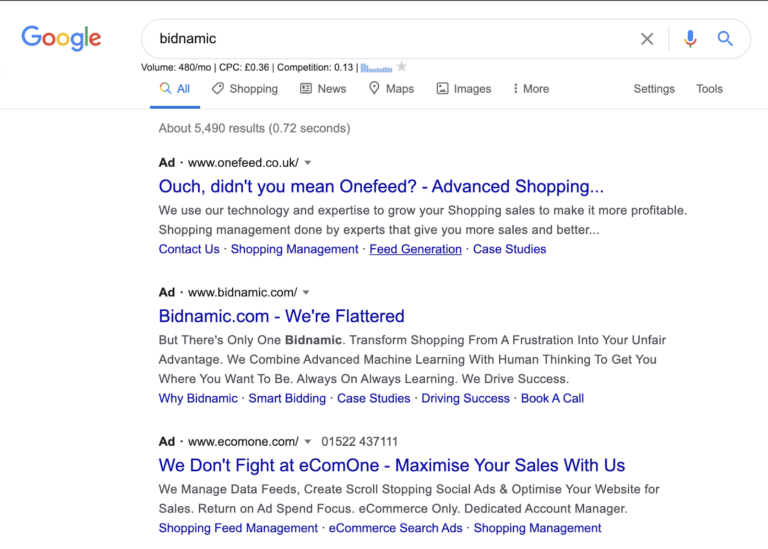Social media image & video sizes 2025
This guide breaks down all the social media image and video sizes you need to know, including LinkedIn, Instagram, Facebook, X (formerly Twitter), YouTube, Pinterest, TikTok and Google Business Profile.

You can’t always Google to stop a competitor or other businesses from bidding on your brand name as a keyword, but you can set up a brand campaign of your own to show up for these results too. Here’s how.
To download our guide to running a brand campaign, fill out your details and we’ll get it sent straight to your inbox.
There’s nothing worse than discovering a competitor’s ad showing up when you type your business name into Google. Or, when you type in your brand name, other businesses come up because your brand name happens to be a name for something else too. Unfortunately, you can’t always Google to stop a competitor or other businesses from bidding on your brand name as a keyword, but you can set up a brand campaign of your own to show up for these results too.
In paid search, a brand campaign is a campaign that only includes keywords related to your brand name. This could also include sub brands, other names your business is commonly referred to, and even misspellings of your brand name. By bidding on your own brand name, you are ensuring that your business will show up above organic results in the search results page – and you’ll be aiming to show up above your competition too, especially if they are bidding on your name.
Rather than (or as well as, depending on how much budget you have) bidding on your competitors’ name, you can run a brand campaign to give you much more control over the messaging that shows up when a potential customer searches for your business. Bidding on your own brand name is often cheaper than bidding on your competitors’ too, because your ad copy and landing pages will be much more relevant to these keywords.
Let’s explore other ways in which a brand campaign can boost your marketing strategy:
If your competitors are bidding on your brand name in Google, then it makes sense to bid on your name too, as a way of protecting your brand reputation. You can’t control what your competitor is writing in their ad copy, but you can have ultimate control over your own ads in the search results. Regularly review what the search results page looks like for your brand name, so you can adjust the messaging on your ads to counter your competitors’ ads and encourage clicks on yours instead!
Here is a nice example of how to deal with your competitor’s ads:

Following on from the first point, running an ad campaign for your brand name gives you another opportunity to manage what searchers will see if they’re looking for you, regardless of whether other advertisers are bidding on your brand name. And, as we’re big fans of testing here at Base Creative, running a brand campaign also gives you the perfect opportunity to test different types of messaging without affecting your SEO efforts. You can try a variety of hooks, incentives and angles for headlines and descriptions, then learn how they impact clickthroughs to your website. If you find a winning headline and description combination, you could then update your page titles and meta descriptions to match, to give your site a boost from an SEO perspective.
Hopefully you rank on page 1 (and ideally within the top #3, if not #1) for your brand name organically. But when ads are showing for your brand name’s search results too, your organic listing often ends up far down the results page. Having both paid and organic listings on the search results page will give your business the chance to dominate the results for your brand name. With a brand campaign, you’ll be able to show up even higher on the search results page, giving you a higher chance of getting that click. Don’t forget to add relevant ad extensions for your brand campaign so you can take up even more real estate on this page through sitelinks, contact details and more, making it even harder for others to compete for clicks on these terms!
Brand campaigns are often responsible for a high ROAS (Return on Ad Spend). This is because bidding on your brand name will typically be much cheaper per click than bidding on the services or products you offer. In a brand campaign, your ads and landing pages will be highly relevant to your keywords, resulting in a higher Quality Score, which will help lower the cost of your ads. There will also be less competition and fewer number of searches for your brand name than other terms. So, if you find that some of your non-branded keywords are starting to get costly, you could introduce a branded campaign to help get relevant traffic to your website at a lower cost per click.
Unless it’s a lucky guess, those typing in your brand name to Google already know who you are. And, as people generally want to do business with those they know, like and trust, it’s likely that they are already part of the way down the sales funnel. Searching for your brand name suggests they’re ready to learn more, or even make an enquiry right away. Combine this with a brand campaign (where ideally you’ll be showing up in multiple listings at the top of page 1) and there’s a good chance you’ll see an increase in high quality leads from those who are lower in the sales funnel.
Convinced to try a brand campaign of your own? Here are a few pointers to get you started:
Through a paid search brand campaign, you can protect your brand reputation and have more chances to encourage interested searchers to click through to your website from their Google search, all for a relatively cheaper cost than other forms of advertising. For more help getting started with a brand campaign, email me at [email protected].
View our other content here
This guide breaks down all the social media image and video sizes you need to know, including LinkedIn, Instagram, Facebook, X (formerly Twitter), YouTube, Pinterest, TikTok and Google Business Profile.
This guide breaks down all the social media image and video sizes you need to know, including LinkedIn, Instagram, Facebook, Twitter, YouTube, Pinterest, TikTok and Google Business Profile.

Whether it’s a tip on how to do something (just like this post!) or an answer to a popular question within your industry, the best blog posts are the ones that provide real value to their readers. So, if you’re wondering what to include in your next blog post (or 10), here’s how to come […]

Lack of time is often the reason accountancy firms don’t market their business, so in this guide, Base Creative shares easy time-saving strategies that all firms can introduce, including automation and content repurposing. In this guide, Base Creative explores: How much time should you spend on marketing Automation in marketing How you can repurpose content […]
